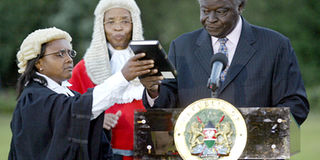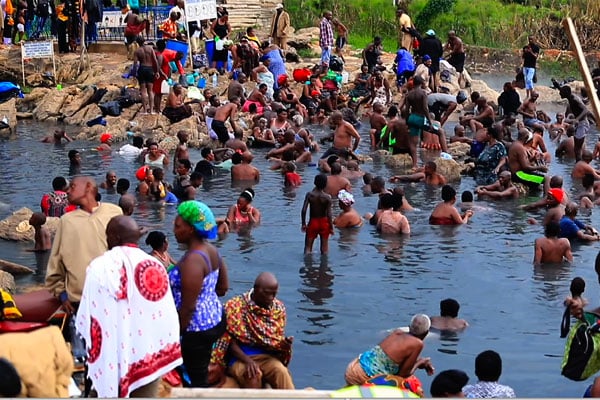Prime
Mwai Kibaki: The man who turned round Kenya’s presidency

Mwai Kibaki being sworn in for his second term after the 2007 controversial presidential elections. File Photo.
As outgoing President Mwai Kibaki cast his vote to usher into office the fourth Kenyan president, he might have taken time to ruminate on the day he, himself, was voted overwhelmingly 10 years ago, in 2002.
He might have reflected on the twists and turns of a remarkable journey for a child from a peasant family in Nyeri to the highest office in the land.
Kibaki will be taking his leave not just after serving two terms at State House, but a lifetime of public service, most of it in the upper echelons of political leadership. It is a life marked by 10 years as president and 10 years as Vice President, with a 10-year interlude in between as an opposition leader. Save for a short stint, two years as an assistant economics lecturer at his alma mater Makerere University, President Kibaki has known no other employment except politics.
The brilliant young economist was plucked by Tom Mboya from the lecture halls of Makerere to take charge as Kenya African National Union’s first executive officer in 1961 at the age of 30. He ran the Independence party’s secretariat before deciding to take his own plunge into politics at the pre-Independence General Election of 1963.
The young Kibaki, at the age of 32, was elected MP for then Doonholm constituency in Nairobi, a larger version of the present-day Makadara constituency.
He held the seat until 1974 when he opted to shift from the uncertain rough and tumble of city politics to a more secure seat in his birthplace, Othaya. Save for one year when he lost his seat on quitting Kanu to form the Democratic Party at the end of 1991, President Kibaki has served continuously in the National Assembly to date, setting a record as the longest serving MP since Independence.
He has been sitting in Parliament with not a single contemporary from those early years, with the present-day veterans having served at least 20 years less than he.
A career as old as Kenya
The story of President Kibaki’s tenure in leadership therefore closely intertwines with the story of Kenya @50 as the country gets set to celebrate in December, a half-century of freedom.
It has been a story of triumphs and tribulations, falling down and getting up, overcoming obstacles, beating the odds and confounding the skeptics. He was scorned as “Vice President for Othaya” as President Moi’s inner clique plotted his removal from the number-two office in the late 1980s.
He became “General Kiguoya (coward)”, as christened by his detractors in the early period of return to the multi-party regime when he suddenly dumped Kanu to join the new bandwagon. A popular newspaper columnist called him the leader who “never saw a fence he did not want to sit on” as the country headed for the first multi-party elections of 1992.
Prior to that, he had also endured with typical equanimity difficult final years as President Moi’s deputy marked by humiliation and clumsy overt steps to undermine and undercut him. President Kibaki could have looked back with quiet satisfaction at two-terms in a transitory stage that vindicate his cautious and sometimes hesitant style of politics and leadership.
They have been difficult terms marked by both success and failure. He came in at a time when Kenyans were conditioned to the presence of a powerful Head of State, Presidents Kenyatta and Moi, who brooked no dissent and whose word was law.
Kenyans were used to a president who is declared Father of the Nation and promoted an overbearing personality cult that included having every important road, stadium, school, airport and market named after himself.
The president was Farmer Number One, Teacher Number One, Footballer Number One and generally the personage around whom the sun revolved.
Every TV and radio news bulletin had to start with dreary and long-winded accounts of the presidents daily diary—attending church service, addressing wananchi at a road-side stop, receiving delegations of politicians or businessmen—even when such mundane events were of absolutely no news value.
Citizens accepted that the president was all-wise, all-powerful, ever -present, and gave the holder of the office power to pontificate on all manner of issues and lay down directives and the laws even when such edicts were patently unlawful and based on ignorance and misinformation.
One of the unappreciated achievements of President Kibaki’s tenure has been style, changing the way Kenyans view their president, demystifying the office and doing away with the personality cult.
He has not had any road, stadium, school or hospital named after him. Other than some commemorative limited-circulation coins, he has not demanded that his face adorn the national currency.
Neither is it mandatory these days that the president’s visage look down on Kenyans from every shop, office and bar.
Unlike Moi and Kenyatta before him, President Kibaki also notably does not issue daily pronouncements and directives. When he took over power on that memorable day at Uhuru Park, one of his major pledges was an end to the “era of roadside policy declarations”.
He has kept true to his word, letting the nation run without his overbearing interference, and giving ministers, permanent secretaries, provincial commissioners, security chiefs and state corporation heads wide latitude to do their work without constantly looking back over their shoulders at a shadow from State House.
A president out of touch?
Of course that has brought its own complications. Sometimes when the nation is looking for leadership, guidance and inspiration—such as at a time of a major national tragedy such as the recent slaughter of some 40 policemen in Suguta Valley—President Kibaki will often remain notably silent.
This creates the notion of an absent, uncaring or out-of-touch leader. Kenya is replete with jokes about a Head of State accustomed to lying in repose at State House as the nation burns.
Then, there are the many Kenyans who still pine for the days of the Big Man, the leader who rules by fiat, ensures all lesser minions follow the straight and narrow path, and who is the country’s centre of gravity.
What some might not appreciate is that while the changing image of the presidency is a direct result of President Kibaki’s own style and approach to leadership, it has also been imposed by a new constitutional and political dispensation.
The new Constitution that came into place in 2010 sought to banish what is commonly referred to as the “Imperial Presidency”. But even prior to that, the president’s room for manoeuvre was limited by some political realities. When he took office after the 2002 elections ending Kanu’s 40-decade monopoly of power, President Kibaki was at the helm of an unwieldy election that dictated he could not rule by decree. The National Alliance Rainbow Coalition (Narc) on which ticket he was elected was itself a merger of pre-election coalitions. The Kibaki-Kijana Wamalwa-Charity Ngilu grouping cobbled together out of their respective outfits had in the last legs of the campaign teamed up with the Raila Odinga-George Saitoti-Kalonzo Musyoka-Moody Awori that had stormed out of Kanu in rebellion against outgoing President Moi’s anointing of newcomer, Uhuru Kenyatta as his preferred successor.
From the word go, therefore, President Kibaki had to play a delicate balancing act limited by the competing interests within his coalition.
It did not help that in the first year of his leadership, the president had been laid low by a hush-hush stroke that allowed a clique of powerful figures in his inner circle to isolate him, rule by proxy and turn State House into an ethnic redoubt.
Even after the Narc collapsed after the abortive 2005 attempt at a new constitution and the ex-Kanu group led by Mr Odinga refashioned themselves as the Orange Democratic Movement, President Kibaki still did not have the leeway to assert his authority as the ‘Big Man’. The group he brought aboard to counter the ODM exit—figures like his presidential election foes, Uhuru Kenyatta of Kanu and Simeon Nyachae of Ford People—would all demand their pound of flesh.
2007 election dented his legacy
Fast Forward to the 2007 elections, and President Kibaki’s disputed victory on the new outfit, PNU, and the post-election violence that marks the black spot in his legacy. The outcome was the enforced coalition marriage that brought his presidential election rival, Raila Odinga into government as Prime Minister.
The deal brokered by former UN Secretary-General, Kofi Annan, to halt the violence that claimed over 1,000 lives and ejected another 600,000 from their homes remains a testimony to two men who at a crucial moment were able to put national interest above ego and power politics.
During the lengthy negotiations preceding the power-sharing agreement, both Mr Kibaki and Mr Odinga were surrounded and advised by hard-liners in their respective camps who would not budge an inch even if that meant burning down the country.
When the two principals were out together alone in the absence of their respective entourages, a deal was quickly struck. The very nature of the Grand Coalition government, however, dictates a dilution of executive authority. The life of the coalition has been marked from Day One by squabbles over everything from ministerial and other public service appointments to the distribution of executive perks.
On the very day that Mr Annan stood with the two principals on the steps of Harambee House to declare “we have a deal”, some Office of the President minions put on a display of comedy by rushing forward to haul away the presidential lectern with its bank of microphones after President Kibaki had spoken. It was of prime importance to them that the incoming Prime Minister does not speak from the same lectern!
Yet, when things got as petty as that and threatened to paralyse workings of the coalition, it took the maturity of the president and the prime minister to get things back on track. The coalition arrangement continues to militate against the return of unbridled executive power, often to the open chagrin of key figures in President Kibaki corner as well as large number of his supporters who do not comprehend why he does not rule like Kenyatta or Moi.
The reality is that even without the constraints of the coalition and the new constitution, President Kibaki simply would not be a Kenyatta or Moi.
Being a dictator, hoarding power, populist actions, or the personality cult simply is not his style.
His has always been a more collegial style of leadership based on delegation of authority; a laid-back approach that does not claim monopoly of knowledge.
Kenyans have largely got used now to a ‘remote’ president, and also, begun to appreciate that a leader must not of necessity be all-powerful.
But there are still questions whether President Kibaki is sometimes too removed, distant and uncaring. In time of major tragedies, the people sometimes want to be reassured that their president does cares and is also in charge.
A fruitful decade
However, Kenyans by now would also appreciate that despite reticence, President Kibaki has recorded some major successes.
From the free primary education that marked his ascent to office; to the roads, rural electrification and other major infrastructural development; the revival or state institutions plundered by the Moi regime; the new constitution and unfettered liberties; the dramatic rise in tax revenues; phenomenal growth in real estate development; the grand plans of Vision 2030: That is the Kibaki legacy.
But as he cast his vote on Monday, March 4, he might also have ruminated that he will be leaving office with so much left to do.
The post-election violence remains a serious blot on his legacy; and there has been little progress in national healing and reconciliation.
There are still complaints of skewed development and power-concentration around a small central Kenya clique.
Thus even as we celebrate The Thika Superhighway, many will still ask why projects to ease the traffic logjam in Mombasa or to open up road links to northern and north-eastern Kenya have been so long coming.
On the balance, however, President Kibaki earns high marks. Kenyans must be proud of the man.




